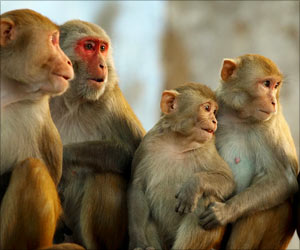- Kyasanur forest disease - (https://pubmed.ncbi.nlm.nih.gov/23110991/)
- Kyasanur Forest Disease (KFD): Rare Disease of Zoonotic Origin - (https://pubmed.ncbi.nlm.nih.gov/28327690/)
- Clinical and Laboratory Diagnostic Features of Kyasanur Forest Disease: A Study From Wayanad, South India - (https://pubmed.ncbi.nlm.nih.gov/35004016/)
- Clinical & epidemiological significance of Kyasanur forest disease - (https://pubmed.ncbi.nlm.nih.gov/30381537/)
- Kyasanur Forest Disease in India: innovative options for intervention - (https://pubmed.ncbi.nlm.nih.gov/30945970/)
About
Monkey fever, also known as Kyasanur Forest Disease (KFD), is a tick-borne viral hemorrhagic fever that poses a significant public health threat, particularly in forested regions. The disease was first identified in 1957 in the Kyasanur Forest in Karnataka, India, hence its name(1✔ ✔Trusted Source
Kyasanur forest disease
Go to source). KFDV belongs to the Flaviviridae family and is transmitted through the bite of infected ticks, primarily Haemaphysalis spinigera(2✔ ✔Trusted Source
Kyasanur Forest Disease (KFD): Rare Disease of Zoonotic Origin
Go to source).
Monkey fever primarily affects individuals who reside in or frequent forested areas where the tick vector is prevalent. The disease cycle involves ticks feeding on infected monkeys and then transmitting the virus to humans through subsequent bites. Due to its zoonotic nature, monkey fever poses a significant risk to individuals who come into contact with infected ticks or animals.
Did You Know?
While Monkey Fever is primarily found in India, cases have also been reported in other countries, including China and Russia. However, the prevalence and death rates outside of India are comparatively lower.What are the Causes of Monkey Fever?
The primary cause of monkey fever is the Kyasanur Forest Disease Virus (KFDV), which is transmitted to humans through the bite of infected ticks. These ticks acquire the virus by feeding on infected monkeys, particularly the black-faced langur and red-faced bonnet monkeys, which serve as natural reservoir hosts for KFDV.
In addition to ticks, other potential modes of transmission include the handling of infected animal tissues or fluids, as well as exposure to contaminated environments. However, tick bites remain the primary route of KFDV transmission to humans, highlighting the importance of tick control measures in preventing the spread of monkey fever.
What are the Symptoms and Signs of Monkey Fever?
The symptoms of monkey fever typically manifest within 3 to 8 days following the tick bite. Initial symptoms include:
- High fever
- Headache
- Muscle pain
- Chills
These symptoms resemble flu-like symptoms. As the disease progresses, more severe symptoms may develop, such as:
- Vomiting
- Diarrhea
Abdominal pain - Hemorrhagic manifestations: nosebleeds, bleeding gums, blood in stools
In some cases, monkey fever can lead to complications such as:
- Liver failure
- Kidney dysfunction
- Neurological symptoms
Severe cases of KFDV may result in death, particularly in individuals who do not receive prompt medical attention and supportive care.
How do you Diagnose Monkey Fever?
Diagnosing monkey fever involves a combination of clinical evaluation, laboratory tests, and epidemiological investigation. Healthcare professionals may perform blood tests to detect the presence of KFDV antibodies or viral RNA. Additionally, epidemiological factors such as recent exposure to tick-infested areas or contact with infected animals are considered during diagnosis.
Laboratory tests commonly used for diagnosing monkey fever include:(3✔ ✔Trusted Source
Clinical and Laboratory Diagnostic Features of Kyasanur Forest Disease: A Study From Wayanad, South India
Go to source)
- Enzyme-linked immunosorbent assay (ELISA)
- Reverse transcription-polymerase chain reaction (RT-PCR)
- Viral isolation from blood samples
These tests help confirm the presence of KFDV in suspected cases and differentiate monkey fever from other febrile illnesses with similar symptoms.
How can you Treat Monkey Fever?
Currently, there is no specific antiviral treatment available for monkey fever. Supportive care is the mainstay of treatment, focusing on alleviating symptoms and preventing complications. Patients with severe cases may require hospitalization for close monitoring and management of complications such as dehydration, bleeding, and organ failure(4✔ ✔Trusted Source
Clinical & epidemiological significance of Kyasanur forest disease
Go to source).
Supportive measures for managing monkey fever include intravenous fluids to maintain hydration, antipyretic medications to reduce fever, and analgesics for pain relief. In severe cases, blood transfusions may be necessary to correct coagulation abnormalities and prevent hemorrhagic complications. Additionally, close monitoring of vital signs and laboratory parameters is essential for the early detection of complications and timely intervention.
Monkey Fever Prevention Tips
Preventing monkey fever primarily involves avoiding tick bites and minimizing contact with infected animals. Key prevention tips include:(5✔ ✔Trusted Source
Kyasanur Forest Disease in India: innovative options for intervention
Go to source)
- Wear long-sleeved clothing and pants
- Use insect repellents containing DEET
- Avoid tick-infested areas
- Conduct thorough tick checks after outdoor activities
Additionally, vaccination against monkey fever is available in endemic regions and is recommended for individuals at high risk of exposure, such as forest workers and researchers.

Thus, monkey fever, or Kyasanur Forest Disease, is a potentially life-threatening viral hemorrhagic fever transmitted by infected ticks. Understanding the causes, symptoms, diagnosis, treatment, and prevention of monkey fever is crucial for mitigating the risk of transmission and preventing outbreaks in endemic regions. Public health efforts aimed at tick control, surveillance, and vaccination play a vital role in combating this emerging infectious disease.








